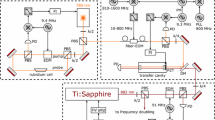Abstract
The frequency stability of an optically pumped ammonia laser operating on the aP(4, 0) transition of 15NH3 at 11.76 μm wavelength has been investigated experimentally. Conditions under which the laser frequency is isolated from variations in pump frequency and cavity length are presented.
Similar content being viewed by others
References
K.J. Siemsen, E. Williams, J. Reid: Optics Lett. 12, 879 (1987)
K.J. Siemsen, A.A. Madej, J. Reid: IEEE J. QE-27, 1199 (1991)
J. Heppner, C.O. Weiss, U. Hubner, G. Schinn: IEEE J. QE-16, 392 (1980)
P.W. Smith, P.J. Maloney: Appl. Phys. Lett. 22, 667 (1973)
K.J. Siemsen, J. Reid: Optics Lett. 10, 594 (1985)
Ch.J. Bordé, J. Bordé, Ch. Breant, Ch. Chardonnet, A. van Lerberghe, Ch. Salomon: In Laser Spectroscopy VII, Springer Ser. Optical Sc., ed. by T.W. Hänsch, Y.R. Shen (Springer, Berlin, Heidelberg 1985) p. 108
The output power of the ammonia laser tunes through a (Lamb) dip as the cavity length changes. The depth of this dip varies with pump power and gas pressure from 0 to 20%. The center of the dip represents the “peak power position”
B. Dahmani, A. Clairon: Int. J. Infr. a. Millimeter Waves 5, 1053 (1984)
F. Laguarta, G. Merkle, J. Heppner, R. Gorbalan, R. Vilaseca: Phys. Rev. Lett. 57, 831 (1986)
C. Freed, L.C. Bradley, R.G. O'Donnell: IEEE J. QE-16, 1195 (1980)
On the other hand, it has been observed that if one forces the ammonia laser to operate on a collisionally populated, rotationally adjacent transition, the influence of the pump frequency on the laser frequency disappears with complete loss of cavity isolation, See, for example, [5].
B.G. Whitford: NRC of Canada (private communication)
Author information
Authors and Affiliations
Rights and permissions
About this article
Cite this article
Siemsen, K.J., Madej, A.A., Hanes, G.R. et al. Improved frequency stability of the ammonia laser. Appl. Phys. B 54, 126–131 (1992). https://doi.org/10.1007/BF00331884
Received:
Accepted:
Issue Date:
DOI: https://doi.org/10.1007/BF00331884




